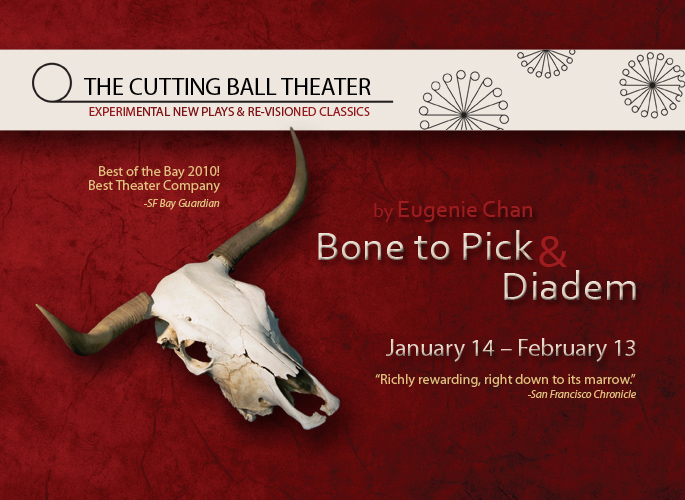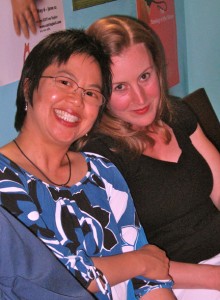Bone to Pick & Diadem
 by Eugenie Chan
by Eugenie Chandirected by Rob Melrose
featuring Paige Rogers
January 14 – February 13, 2011A reimagining of the myth of Ariadne, Theseus and the Minotaur in a postmodern exploration, Bone to Pick received its world premiere at Cutting Ball in 2008. The San Francisco Chronicle called Paige Rogers’ performance “riveting.” For this restaging, Rogers will reprise her tour-de-force role of Ariadne as a waitress in a diner, 3000 years after she was first left on the island of Naxos, now a deserted U.S. Army base.Accompanying Bone to Pick is a newly commissioned companion piece called Diadem, also by Chan, which examines the day that Ariadne is abandoned by her young husband. Together, these two original works tell the complete story of Ariadne’s epic romance.
Bone to Pick & Diadem run approximately 90 minutes, including a 15-minute intermission.
 Paige Rogers is the Associate Artistic Director and co-founder of The Cutting Ball Theater where she has appeared in My Head Was a Sledgehammer, As You Like It, The Vomit Talk of Ghosts, Macbeth, The Taming of the Shrew, Bone to Pick and The Bald Soprano as well as many readings and workshops. She has worked locally with Berkeley Opera, Lamplighters, Sonoma Rep and on tour with Cal Shakes. Nationally, she has been seen at The Kennedy Center, McCarter Theatre, Trinity Rep and the Oregon Shakespeare Festival. Her directing credits at Cutting Ball include Lighthouse, Mud and next year's Tontlawald, also written by Eugenie Chan.
Paige Rogers is the Associate Artistic Director and co-founder of The Cutting Ball Theater where she has appeared in My Head Was a Sledgehammer, As You Like It, The Vomit Talk of Ghosts, Macbeth, The Taming of the Shrew, Bone to Pick and The Bald Soprano as well as many readings and workshops. She has worked locally with Berkeley Opera, Lamplighters, Sonoma Rep and on tour with Cal Shakes. Nationally, she has been seen at The Kennedy Center, McCarter Theatre, Trinity Rep and the Oregon Shakespeare Festival. Her directing credits at Cutting Ball include Lighthouse, Mud and next year's Tontlawald, also written by Eugenie Chan.
 Eugenie Chan Eugenie Chan is a 5th generation San Franciscan whose forefathers sold slippers in Chinatown, dry goods in the desert, and love in the bordellos. No wonder her plays tend to mix up language, reality, tradition, and history. Her work includes, Kitchen Table; Bone to Pick; Diadem; Daphne Does Dim Sum; Rancho Grande; Emil, A Chinese Play; Novell-aah!; Pilgrim; Consent; Circus; and opera libretto for Snakewoman. Theatres that have produced or developed her plays include, on the West Coast: Cutting Ball Theater, Thick Description, Magic Theatre, Bay Area Playwrights Festival, Northwest Asian American Theatre, Group Theatre, East West Players, and the Asian American Theater Company; on the East Coast: The Public, Playwrights Horizons, Ma-Yi, Centenary Stage, Pan Asian Rep, and Perishable Theatre;. Eugenie has received commissions from Cutting Ball, the San Francisco Arts Commission, Houston Grand Opera, Magic/Sloan Science Initiative, and the San Francisco Foundation; awards from Mixed Blood Theatre, NYU; grants from the San Francisco and Wallace Foundations, the Lippmann Family, TBA New Works, CA$H; and fellowships and residencies from Sundance, Berilla Kerr, Tournesol, Film Arts, Hedgebrook, Millay, Djerassi, among others. Her work is published in Alexander Street Press’ Asian American Drama and North American Women Writers, and Lexington Books’ Embodiments of Asian/American and Pacific Islander/ American Sexualities. She is a proud Resident Playwright at Cutting Ball, the Playwrights Foundation and New Dramatists. Eugenie has also written political satire for the San Francisco Mime Troupe and screenplays which have been semifinalists for Nicholl and Cinestory Fellowships. She holds a BA in Literature from Yale and an MFA from NYU.
Eugenie Chan Eugenie Chan is a 5th generation San Franciscan whose forefathers sold slippers in Chinatown, dry goods in the desert, and love in the bordellos. No wonder her plays tend to mix up language, reality, tradition, and history. Her work includes, Kitchen Table; Bone to Pick; Diadem; Daphne Does Dim Sum; Rancho Grande; Emil, A Chinese Play; Novell-aah!; Pilgrim; Consent; Circus; and opera libretto for Snakewoman. Theatres that have produced or developed her plays include, on the West Coast: Cutting Ball Theater, Thick Description, Magic Theatre, Bay Area Playwrights Festival, Northwest Asian American Theatre, Group Theatre, East West Players, and the Asian American Theater Company; on the East Coast: The Public, Playwrights Horizons, Ma-Yi, Centenary Stage, Pan Asian Rep, and Perishable Theatre;. Eugenie has received commissions from Cutting Ball, the San Francisco Arts Commission, Houston Grand Opera, Magic/Sloan Science Initiative, and the San Francisco Foundation; awards from Mixed Blood Theatre, NYU; grants from the San Francisco and Wallace Foundations, the Lippmann Family, TBA New Works, CA$H; and fellowships and residencies from Sundance, Berilla Kerr, Tournesol, Film Arts, Hedgebrook, Millay, Djerassi, among others. Her work is published in Alexander Street Press’ Asian American Drama and North American Women Writers, and Lexington Books’ Embodiments of Asian/American and Pacific Islander/ American Sexualities. She is a proud Resident Playwright at Cutting Ball, the Playwrights Foundation and New Dramatists. Eugenie has also written political satire for the San Francisco Mime Troupe and screenplays which have been semifinalists for Nicholl and Cinestory Fellowships. She holds a BA in Literature from Yale and an MFA from NYU.

Playwright Eugenie Chan and Actor Paige Rogers
Reviews
Welcome to Bone to Pick & Diadem!
This whole thing started when I was late to a meeting. I was teaching at Marin Academy and, because Paige was home sick with our baby, I tried to sneak in late to a faculty meeting unnoticed, but someone said, “Stop. Rob, don’t forget to put your name in the hat.” It turns out, I walked in just as they were raffling off some donated British Airways miles…enough miles for two people to fly anywhere in the world. Since my slip of paper was on top, of course my name was drawn. Sometimes it pays to be fashionably late! What followed was a trip to Greece and Crete with Paige and our nine-month old Charlotte.
I’ve been obsessed with Greek mythology since I was a young boy. I am especially drawn to the myths about the ancient Minoan civilization on Crete: the Minotaur, Ariadne, Theseus, Daedalus, Icarus, Pasiphaë, and King Minos. Reading Riane Eisler’s wonderful book on Goddess mythology (and much more) The Chalice and the Blade only deepened this love. When Paige, Charlotte, and I were walking around the reconstructed ruins of Knossos in Crete, I felt a deep connection with some of humanity’s oldest stories.
Cutting Ball has long flirted with the idea of creating a compact show that could eventually tour. Four years ago, a grant from the Magic Theatre / Z Space New Works Initiative allowed us to commission a play for the first time in our history. We thought about what kind of show could capture the essence of Cutting Ball: rich language, evocative design and compelling acting. We commissioned Eugenie Chan (now our resident playwright) to write a play for Paige about the myths of Crete. Eugenie wrote Bone to Pick for our 2008 Avant GardARAMA! and it was the stand-out play of the evening. We wondered if we could create a companion piece to go with Bone to Pick that would set up the myth of Ariadne and the Minotaur for Bone. This led us to commission Eugenie to write a play about the earlier parts of the story, when she was young and hopeful.
Now, for the first time, we are pleased to present Diadem and Bone to Pick together. We hope you enjoy the fruits of this journey!
Enjoy!

Rob Melrose
Artistic Director
Notes from Dramaturg Megan Cohen
We know that Ariadne was a Princess, born and raised on Crete. You’ll find Ariadne mentioned in Homer, in Plutarch, in Catallus, in Seneca, in Ovid, and in many other classical texts, but as with so many long-gone figures, the stories about her disagree and vary tremendously. She was wily or she was naive. She was a lusty witch, or she was an innocent Princess with a pure heart, who drew the short straw from fate, or from men. What we know of Ariadne, these surviving stories and myths, these fragments and footnote mentions, are a pile of ancient ruins.
We know that she fell in love with the Athenian Prince Theseus, and she gave him the ball of golden thread that allowed him to escape from the terrifying, man-eating Minotaur that lived in the heart of Crete’s deadly labyrinth. We know that Theseus killed the Minotaur and escaped with Ariadne to Naxos, where he abandoned her before returning home to Greece. We know that Ariadne and the Minotaur shared a mother, the Queen Pasiphaë. Pasiphaë lay with her husband King Minos of Crete to produce Ariadne, and lay with a powerful, fearsome bull to produce the Minotaur. So, in a nutshell, we know that Ariadne helped Theseus, the handsome foreign prince, slay her monstrous brother, and we know it was because of love, and that it ended quite badly for her.
Well, we think so. To be fair, we don’t exactly know these exact things, because there is no definitive version of Ariadne’s tale; some versions of Ariadne’s story give other parents, other places, other timelines. We are pretty sure about these basic parts of the myth, and if we do not know “for sure,” we know “for sure enough.” What else do we know, or need to know?
We know that Ariadne’s mother Pasiphaë was the daughter of the sun-god Helios and the nymph Perseis. Her name means “wide-shining,” or “all-shining,” and she was born and raised as a Princess in Colchis, the palace of the sun, in the east. Rather than simply “bright like the sun,” we might think of her personality as “scorching hot.” We know that to lay with the bull who fathered the Minotaur, she employed the inventor Daedalus (also the creator of the labyrinth) to construct for her a box that she could climb into, an elaborate contraption that gave the appearance of a cow, so it both enticed the bull and allowed the queen to safely copulate with him. We don’t know for sure where the bull came from or who sent him, and in Diadem Ariadne doesn’t know either, and tells us some of the possibilities, some of the gossip, some of the contenders who might have thrown this one great problem into her parents’ marriage.
We know that although Pasiphaë was an adulteress who lay with a bull, she would not tolerate any infidelity from her husband Minos; she bewitched him with an herbal potion which ensured that if he lay with another woman, he would ejaculate serpents and scorpions, who would slaughter his paramour from the inside out. We can imagine Pasiphaë as raw, passionate, and larger than life. We know this is the woman who raised Ariadne, who set her expectations for how men and women treat each other.
We know that Ariadne’s life-long love and briefly-held husband Theseus was a prince of Athens. We do not know if his father was the powerful king Aegeus or the sea-god Poseidon; many versions of the story tell us it was both. We know that he killed the Minotaur. We know that the Minotaur beast required an sacrifice of live humans, seven beautiful girls and seven beautiful boys, every seven years – or every nine; we do not know for sure. We do know that King Minos of Crete, Ariadne’s father, was sending captured Athenian youths into the labyrinth to meet this quota of blood, and that Theseus went in disguise as one of these youths, in order to slay the monster.
We know that when Theseus arrived in Crete, he met Ariadne. She fell in love with him, and he promised that if he survived the labyrinth, he would take her away as his bride. She gave him the ball of golden string that would guide him through and out of the maze of tunnels, and he did escape safely, with all the virgin sacrifices safely in tow, having slain the Minotaur. We know he took Ariadne with him from Crete, as his bride, and then abandoned her, alone, on the island of Naxos, and never returned. Some stories say that Dionysus made the Prince do this out of jealousy, because the god had his eye on making Ariadne his own. Others simply don’t place any blame, or give any explanation, for Ariadne’s abandonment. We do know that later in life, Theseus married her younger sister Phaedra.
With Eugenie Chan, we imagine that before Theseus left Ariadne on Naxos, he promised her the world. We imagine they were lovers. We imagine the morning after. The decades after. The life after. We imagine, but we don’t know.
Megan Cohen, dramaturg
Synopsis
In Greek mythology, Ariadne’s father Minos was the king of Crete. Poseidon, the god of the sea, gave Minos a beautiful white bull that rose out of the ocean. Minos planned to sacrifice the bull to Poseidon and then thought better of it and sacrificed a lesser bull to him. Poseidon cursed Minos’s wife Pasiphaë to fall in love with the white bull. She convinced the inventor Daedalus to create a cow-machine that she could lie in and mate with the bull. The result of this mating was a half-man/half-bull called the Minotaur. Minos instructed Daedalus to create a labyrinth to hold the Minotaur from which no one could escape.
Crete was at war with Athens. As a peace settlement, Minos demanded that Athens must send Crete seven young men and seven virgin maidens every seven years to be sacrificed to the voracious Minotaur. In order to stop this barbaric practice, Theseus, the prince of Athens, offered to sacrifice himself, planning to slay the Minotaur instead of being slain himself. When Theseus arrived in Crete, Ariadne fell instantly in love with him. He promised to marry her if she could tell him the secret to surviving the maze. Ariadne asked Daedalus, and he told her the answer. Theseus needed to bring a ball of string with him into the labyrinth and tie one end to a tree outside. That way, no matter how deep he got into the maze, he could always find his way back. This plan proved successful; Theseus did indeed kill the Minotaur and took Ariadne with him as he fled Crete. But on the way to Athens, their ship stopped on the island of Naxos and he left her there, forgotten…
Diadem takes place the morning after Theseus and Ariadne land on Naxos. Bone to Pick imagines Ariadne stuck on the island of Naxos for over 3000 years after being abandoned. While her native Crete was the center of power 3000 years ago, now Ria’s culture reflects that of our current super-power.